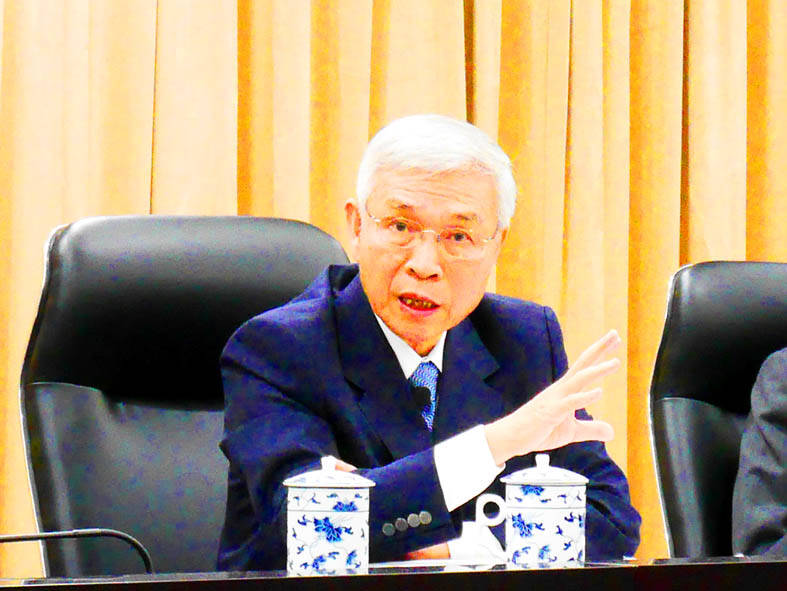Taiwan’s financial industry should seize the opportunity to work with local firms seeking to set up operations overseas, especially in ASEAN countries, as that would help them pursue further internationalization and expand the capacity of their overseas operations, central bank Governor Yang Chin-long (楊金龍) said on Saturday.
Speaking at a forum about the latest developments in globalization and Taiwan’s responses to it, hosted by National Cheng Chi University, Yang said that by providing services to Taiwanese businesses relocating their overseas bases, local financial institutions can bring financial services to various countries and develop more new frontier markets.
With the collaboration and support of their domestic banking units and offshore banking units, Taiwan’s financial institutions can develop into a trade settlement and fund management center for overseas Taiwanese businesses, Yang said.

Photo: Chen Mei-ying, Taipei Times
Based on central bank statistics, Taiwanese banks’ loans extended to customers in the ASEAN region, mainly Taiwanese businesses with operations there, had increased to 22.9 percent of total lending at the end of last year, up from 8.1 percent in 2017.
The ASEAN countries have become a key area for Taiwanese banks’ overseas expansion in recent years, with the banks setting up more overseas branches in this region than elsewhere, Yang said.
By the end of March, Taiwanese banks had established a total of 174 overseas branches, with ASEAN accounting for the most at 51, an increase of 12 from 2015, followed by mainland China with 30, the US with 27 and Hong Kong with 20, the central bank’s statistics showed.
The assets of Taiwanese banks’ ASEAN branches have also grown rapidly recently, reaching NT$1.55 trillion (US$49.4 billion) at the end of March, second only to the NT$1.81 trillion of the Hong Kong branches, but higher than the NT$1.15 trillion of those in mainland China, the data showed.
As the number of branches and operations have expanded, the profits of ASEAN branches have increased significantly, according to the central bank.
Last year, ASEAN branches’ combined profit reached a new high of NT$14.7 billion, accounting for 25.8 percent of banks’ total overseas profits, second only to the NT$21.5 billion profit made by their Hong Kong branches, but higher than the NT$5.5 billion profit contributed from branches in mainland China, the central bank’s data indicated.
“The asset scale and profit of Taiwanese banks’ ASEAN branches have surpassed those in mainland China, being second only to Hong Kong, reflecting that banks have followed Taiwanese businesses to ASEAN members to increase their overall operating capacity and profitability,” Yang said.
As Taiwanese firms continue to adjust their overseas production bases in response to US-China confrontations and the challenges of globalization, the realignment of supply chains has resulted in changes in Taiwan’s foreign investment and trade development, as well as changes in the flow of cross-border funds for firms, Yang said.
“On the one hand, it has expanded Taiwan’s economic hinterland, but on the other it has also helped improve the situation of highly concentrated investment and production in China seen in the past,” he said.
However, the governor warned that US-China tensions have led to an increase in Taiwan’s trade surplus in recent years, which could trigger sanctions against Taiwan by Washington if the issue is left unresolved.

Semiconductor business between Taiwan and the US is a “win-win” model for both sides given the high level of complementarity, the government said yesterday responding to tariff threats from US President Donald Trump. Home to the world’s largest contract chipmaker, Taiwan Semiconductor Manufacturing Co (TSMC, 台積電), Taiwan is a key link in the global technology supply chain for companies such as Apple Inc and Nvidia Corp. Trump said on Monday he plans to impose tariffs on imported chips, pharmaceuticals and steel in an effort to get the producers to make them in the US. “Taiwan and the US semiconductor and other technology industries

SMALL AND EFFICIENT: The Chinese AI app’s initial success has spurred worries in the US that its tech giants’ massive AI spending needs re-evaluation, a market strategist said Chinese artificial intelligence (AI) start-up DeepSeek’s (深度求索) eponymous AI assistant rocketed to the top of Apple Inc’s iPhone download charts, stirring doubts in Silicon Valley about the strength of the US’ technological dominance. The app’s underlying AI model is widely seen as competitive with OpenAI and Meta Platforms Inc’s latest. Its claim that it cost much less to train and develop triggered share moves across Asia’s supply chain. Chinese tech firms linked to DeepSeek, such as Iflytek Co (科大訊飛), surged yesterday, while chipmaking tool makers like Advantest Corp slumped on the potential threat to demand for Nvidia Corp’s AI accelerators. US stock

The US Federal Reserve is expected to announce a pause in rate cuts on Wednesday, as policymakers look to continue tackling inflation under close and vocal scrutiny from US President Donald Trump. The Fed cut its key lending rate by a full percentage point in the final four months of last year and indicated it would move more cautiously going forward amid an uptick in inflation away from its long-term target of 2 percent. “I think they will do nothing, and I think they should do nothing,” Federal Reserve Bank of St Louis former president Jim Bullard said. “I think the

SUBSIDIES: The nominee for commerce secretary indicated the Trump administration wants to put its stamp on the plan, but not unravel it entirely US President Donald Trump’s pick to lead the agency in charge of a US$52 billion semiconductor subsidy program declined to give it unqualified support, raising questions about the disbursement of funds to companies like Intel Corp and Taiwan Semiconductor Manufacturing Co (台積電). “I can’t say that I can honor something I haven’t read,” Howard Lutnick, Trump’s nominee for commerce secretary, said of the binding CHIPS and Science Act awards in a confirmation hearing on Wednesday. “To the extent monies have been disbursed, I would commit to rigorously enforcing documents that have been signed by those companies to make sure we get